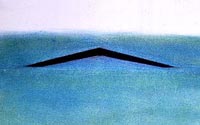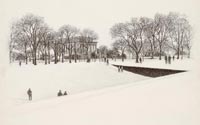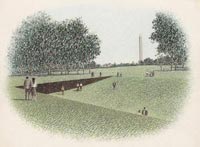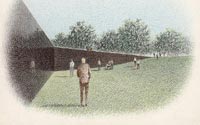Vietnam Veterans
Memorial

Maya Ying Lin (b. 1959)
Vietnam Veterans Memorial proposal
Mixed media on paper on board, 1981
Prints & Photographs Division
LC-USZC4-4915



Paul Stevenson Oles
Perspective drawings, Vietnam Veterans Memorial [June 15, 1981]
Charcoal and Prismacolor pencil drawings
on rag board
Prints & Photographs
Division
Transfer from the Vietnam Veterans Memorial Fund, 1984 (82.7a-c)
[Digital ID#s ppmsca-05607, ppmsca-05608, ppmsca-05609]
|
"At the going down of the sun and in the morning
We will remember them"
-- Laurence Binyon "For the Fallen"
The Vietnam Veterans Memorial, originally designed as a student
project by Maya Lin at Yale University's School of Architecture
in 1981, has become a profound symbol that has served to unify and
reconcile a nation sorely divided by a foreign entanglement. Lin
envisioned a black granite wall, in the shape of a V, on which the
names of the American military dead and missing would be inscribed.
The architect hoped that "these names, seemingly infinite in number,
[would] convey the sense of overwhelming numbers, while unifying
these individuals into a whole."
Since its unveiling in 1982, the work--popularly known as "the
wall"--has become a point of reference, inspiring a new generation
of American memorials. Maya Lin's drawing is one of 1,421 design-competition
submissions documented in the Library of Congress as part of the
Papers of the Vietnam Veterans Memorial Fund.
Architect/artist Paul Stevenson Oles recalled about his role in
the initial phase of the Vietnam Veterans Memorial: “. .
. shortly after we had learned our entry had not been selected
as the winner, I received a frantic telephone call . . . from the
competition’s Professional Advisor Paul Sprieregen, informing
me that the drawings of the winner’s original submission
were so vague—beautiful, indeed, but highly ambiguous. .
. . He asked me if I could produce, say, three drawings for the
purpose of explaining Maya Lin’s design, in a hurry . . .
In those heady hours, Maya asked, shyly, if “she could be
included in the picture.” I agreed, conditionally, if she
would be willing to appear on the arm of the illustrator (center
drawing).”
|

